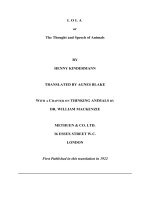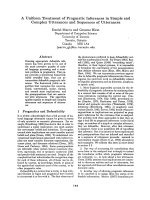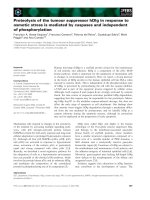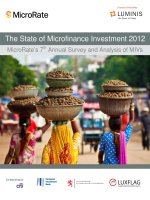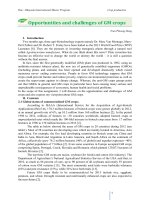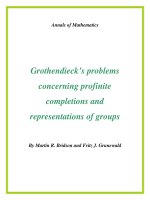CHARACTER AND VARIETIES OF MANURES EXCREMENTS OF ANIMALS pot
Bạn đang xem bản rút gọn của tài liệu. Xem và tải ngay bản đầy đủ của tài liệu tại đây (206.12 KB, 16 trang )
CHARACTER AND VARIETIES OF MANURES -
EXCREMENTS OF ANIMALS
What must a farmer know in order to avoid failures?
Can this be learned entirely from observation?
What kind of action have manures?
Give examples of each of these.
May mechanical effects be produced by chemical action?
How does potash affect the soil?
To understand the science of manures is the most important branch of practical
farming. No baker would be called a good practical baker who kept his flour exposed
to the sun and rain. No shoemaker would be called a good practical shoemaker, who
used morocco for the soles of his shoes, and heavy leather for the uppers. No
carpenter would be called a good practical carpenter, who tried to build a house
without nails, or other fastenings. So with the farmer. He cannot be called a good
practical farmer if he keeps the materials, from which he is to make plants, in such a
condition, that they will have their value[Pg 94] destroyed, uses them in the wrong
places, or tries to put them together without having every thing present that is
necessary. Before he can avoid failures with certainty, he must know what manures
are composed of, how they are to be preserved, where they are needed, and what kinds
are required. True, he may from observation and experience, guess at results, but he
cannot know that he is right until he has learned the facts above named. In this section
of our work, we mean to convey some of the information necessary to this branch
of practical farming.
We shall adopt a classification of the subject somewhat different from that found in
most works on manures, but the facts are the same. The action of manures is
eithermechanical or chemical, or a combination of both. For instance: some kinds of
manure improve the mechanical character of the soil, such as those which loosen stiff
clay soils, or others which render light sandy soils compact—these are
calledmechanical manures. Some again furnish food for plants—these are
called chemicalmanures.
Many mechanical manures produce their effects by means of chemical action.
Thuspotash combines chemically with sand in the soil. In so doing, it[Pg 95] roughens
the surfaces of the particles of sand, and renders the soil less liable to be compacted by
rains. In this manner, it acts as a mechanical manure. The compound of sand and
potash,
[U]
as well as the potash alone, may enter into the composition of plants, and
hence it is a chemical manure. In other words, potash belongs to both classes
described above.
It is important that this distinction should be well understood by the learner, as the
words "mechanical" and "chemical" in connection with manures will be made use of
throughout the following pages.
What are absorbents?
What kind of manure is charcoal?
There is another class of manures which we shall call absorbents. These comprise
those substances which have the power of taking up fertilizing matters, and retaining
them for the use of plants. For instance, charcoal is an absorbent. As was stated in the
section on soils, this substance is a retainer of all fertilizing gases and many minerals.
Other matters made use of in agriculture have the same effect. These absorbents will
be spoken of more fully in their proper places.
TABLE.
MECHANICAL MANURES
are those which improve the mechanical condition of soils.
[Pg
96]CHEMICAL "
are those which serve as food for plants.
ABSORBENTS
are those substances which absorb and retain fertilizing
matters.
Into what classes may manures be divided?
What are organic manures?
Inorganic? Atmospheric?
Manures may be divided into three classes, viz.: organic, inorganic, andatmospheric.
ORGANIC manures comprise all animal and vegetable matters which are used to
fertilize the soil, such as dung, muck, etc.
INORGANIC manures are those which are of a purely mineral character, such as lime,
ashes, etc.
ATMOSPHERIC manures consist of those organic manures which are in the form of
gases in the atmosphere, and which are absorbed by rains and carried to the soil.
These are of immense importance. The ammonia and carbonic acid in the air are
atmospheric manures.
FOOTNOTES:
[U]Silicate of potash.
EXCREMENTS OF ANIMALS
Of what is animal excrement composed?
Explain the composition of the food of animals.
What does hay contain?
To what does Liebig compare the consumption of food by animals, and why?
The first organic manure which we shall examine, is animal excrement.
This is composed of those matters which have been eaten by the animal as food, and
have been thrown off as solid or liquid manure. In order that[Pg 97] we may know of
what they consist, we must refer to the composition of food and examine the process
of digestion.
The food of animals, we have seen to consist of both organic and inorganic matter.
The organic part may be divided into two classes, i. e., that portion which contains
nitrogen—such as gluten, albumen, etc., and that which does not contain nitrogen—
such as starch, sugar, oil, etc.
The inorganic part of food may also be divided into soluble matter
and insolublematter.
DIGESTION AND ITS PRODUCTS.
Of what does that part of dung consist which resembles soot?
What else does the dung contain?
In what manner does the digested part of food escape from the body?
Let us now suppose that we have a full-grown ox, which is not increasing in any of his
parts, but only consumes food to keep up his respiration, and to supply the natural
wastes of his body. To this ox we will feed a ton of hay which contains organic
matter, with and without nitrogen, and soluble and insoluble inorganic substances.
Now let us try to follow it through its changes in the animal, and observe its
destination. Liebig compares the consumption of food by animals to the imperfect
burning of wood in a stove, where a portion of the fuel is resolved into gases and
ashes (that is, it is completely burned), and[Pg 98] another portion, which is not
thoroughly burned, passes off as soot. In the animal action in question, the food
undergoes changes which are similar to this burning of wood. A part of the food
is digested and taken up by the blood, while another portion remains undigested, and
passes the bowels as solid dung—corresponding to soot. This part of the dung then,
we see is merely so much of the food as passes through the system without being
materially changed. Its nature is easily understood. It contains organic and inorganic
matter in nearly the same condition as they existed in the hay. They have been
rendered finer and softer, but their chemical character is not materially altered. The
dung also contains small quantities of nitrogenous matter, which leaked out, as it
were, from the stomach and intestines. The digested food, however, undergoes further
changes which affect its character, and it escapes from the body in three ways—i. e.,
through the lungs, through the bladder, and through the bowels. It will be recollected
from the first section of this book, p. 22, that the carbon in the blood of animals, unites
with the oxygen of the air drawn into the lungs, and is thrown off in the breath as
carbonic acid. The hydrogen and oxygen unite to form a part of the water which
constitutes the moisture of the breath.[Pg 99]
Explain the escape of carbon, hydrogen and oxygen.
What becomes of the nitrogenous parts?
How is the soluble ash of the digested food parted with?
The insoluble?
If any portions of the food are not returned in the dung, how are they disposed of?
That portion of the organic part of the hay which has been taken up by the blood of the
ox, and which does not contain nitrogen (corresponding to the first class of
proximates, as described in Sect. I), is emitted through the lungs. It consists, as will be
recollected, of carbon, hydrogen and oxygen, and these assume, in respiration, the
form of carbonic acid and water.
The organic matter of the digested hay, in the blood, which contains nitrogen
(corresponding to the second class of proximates, described in Sect. I), goes to
thebladder, where it assumes the form of urea—a constituent of urine or liquid
manure.
We have now disposed of the imperfectly digested food (dung), and of
the organicmatter which was taken up by the blood. All that remains to be examined
is the inorganic or mineral matter in the blood, which would have become ashes, if the
hay had been burned. The soluble part of this inorganic matter passes into the bladder,
and forms the inorganic part of urine. The insoluble part passes the bowels, in
connection with the dung.
How is their place supplied?
Is food put out of existence when it is fed to animals?
What does the solid dung contain? Liquid manure? The breath?
If any of the food taken up by the blood is not returned as above stated, it goes to form
fat, muscle, hair, bones, or some other part of the animal, and as[Pg 100] he is not
growing (not increasing in weight) an equivalent amount of the body of the animal
goes to the manure to take the place of the part retained.
[V]
We now have our subject in a form to be readily understood. We learn that when food
is given to animals it is not put out of existence, but is merely changed in form; and
that in the impurities of the breath, we have a large portion of those parts of the food
which plants obtain from air and from water; while the solid and liquid excrements
contain all that was taken by the plants from the soil and manures.
The SOLID DUNG contains the undigested parts of the food, the insoluble parts of the ash, and the
nitrogenous matters which have escaped from the digestive organs.
"LIQUID MANURE" the nitrogenous or second class of proximates of the [Pg 101]digested food, and
the soluble parts of the ash.
THE BREATH contains the first class of proximates, those which contain carbon, hydrogen and
oxygen, but no nitrogen.
[W]
FOOTNOTES:
[V]This account of digestion is not, perhaps, strictly accurate in a physiological point
of view, but it is sufficiently so to give an elementary understanding of the character
of excrements as manures.
[W]The excrements of animals contain more or less of sulphur, and sometimes small
quantities of phosphorus.
WASTE OF MANURE.
What are the first causes of loss of manure?
What is evaporation?
The loss of manure is a subject which demands most serious attention. Until within a
few years, little was known about the true character of manures, and consequently, of
the importance of protecting them against loss.
The first causes of waste are evaporation and leaching.
EVAPORATION.
Name a solid body which evaporates.
What takes place when a dead animal is exposed to the atmosphere for a sufficient
time?
What often assist the evaporation of solids?
Evaporation is the changing of a solid or liquid body to a vapory form. Thus common
smelling salts, a solid, if left exposed, passes into the atmosphere in[Pg 102] the form
of a gas or vapor. Water, a liquid, evaporates, and becomes a vapor in the atmosphere.
This is the case with very many substances, and in organic nature, both solid and
liquid, they are liable to assume a gaseous form, and become mixed with the
atmosphere. They are not destroyed, but are merely changed in form.
As an instance of this action, suppose an animal to die and to decay on the surface of
the earth. After a time, the flesh will entirely disappear, but is not lost. It no longer
exists as the flesh of an animal, but its carbon, hydrogen, oxygen, and nitrogen, still
exist in the air. They have been liberated from the attractions which held them
together, and have passed away; but (as we already know from what has been said in a
former section) they are ready to be again taken up by plants, and pressed into the
service of life.
The evaporation of liquids may take place without the aid of any thing but heat; still,
in the case of solids, it is often assisted by decay and combustion, which break up the
bonds that hold the constituents of bodies together, and thus enable them to return to
the atmosphere, from which they were originally derived.
What is the cause of odor?
When we perceive an odor, what is taking place?
Why do manures give off offensive odors?
How may we detect ammonia escaping from manure?
It must be recollected that every thing, which has[Pg 103] an odor (or can be smelled),
is evaporating. The odor is caused by parts of the body floating in the air, and acting
on the nerves of the nose. This is an invariable rule; and, when we perceive an odor,
we may be sure that parts of the material, from which it emanates, are escaping. If we
perceive the odor of an apple, it is because parts of the volatile oils of the apple enter
the nose. The same is true when we smell hartshorn, cologne, etc.
Manures made by animals have an offensive odor, simply because volatile parts of the
manure escape into the air, and are therefore made perceptible. All organic parts in
turn become volatile, assuming a gaseous form as they decompose.
We do not see the gases rising, but there are many ways by which we can detect them.
If we wave a feather over a manure heap, from which ammonia is escaping, the
feather having been recently dipped in manure, white fumes will appear around the
feather, being the muriate of ammonia formed by the union of the escaping gas with
the muriatic acid. Not only ammonia, but also carbonic acid, and other gases which
are useful to vegetation escape, and are given to the winds. Indeed it may be stated in
few words that all of the organic part of plants (all that was obtained from the air,
water, and ammonia),[Pg 104] constituting more than nine tenths of their dry weight,
may be evaporated by the assistance of decay or combustion. The organic part
of manuresmay be lost in the same manner; and, if the process of decomposition be
continued long enough, nothing but a mass of mineral matter will remain, except
perhaps a small quantity of carbon which has not been resolved into carbonic acid.
What remains after manure has been long exposed to decomposition?
What gaseous compounds are formed by the decomposition of manures?
The proportion of solid manure lost by evaporation (made by the assistance of decay),
is a very large part of the whole. Manure cannot be kept a single day in its natural
state without losing something. It commences to give out an offensive odor
immediately, and this odor is occasioned, as was before stated, by the loss of some of
its fertilizing parts.
Animal manure contains, as will be seen by reference to p. 100, all of the substances
contained in plants, though not always in the correct relative proportions to each other.
When decomposition commences, the carbon unites with the oxygen of the air, and
passes off as carbonic acid; the hydrogen and oxygen combine to form water (which
evaporates), and the nitrogen is mostly resolved into ammonia, which escapes into the
atmosphere.[Pg 105]
Describe fire-fanging.
What takes place when animal manure is exposed in an open barn-yard?
What does liquid manure lose by evaporation?
If manure is thrown into heaps, it often ferments so rapidly as to produce sufficient
heat to set fire to some parts of the manure, and cause it to be thrown off with greater
rapidity. This may be observed in nearly all heaps of animal excrement. When they
have lain for some time in mild weather, gray streaks of ashes are often to be seen in
the centre of the pile. The organic part of the manure having been burned away,
nothing but the ash remains,—this is called fire-fanging.
Manures kept in cellars without being mixed with refuse matter are subject to the
same losses.
When kept in the yard, they are still liable to be lost by evaporation. They are here
often saturated with water, and this water in its evaporation carries away the ammonia,
and carbonic acid which it has obtained from the rotting mass. The evaporation of the
water is rapidly carried on, on account of the great extent of surface. The whole mass
is spongy, and soaks the liquids up from below (through hollow straws, etc.), to be
evaporated at the surface on the same principle as causes the wick of a lamp to draw
up the oil to supply fuel for the flame.
LIQUID MANURE containing large quantities of nitrogen, and forming much ammonia,
is also liable to lose all of its organic part from evaporation (and[Pg
106] fermentation), so that it is rendered as much less valuable as is the solid dung.
[X]
When does the waste of exposed manure commence?
What does economy of manure require?
What is the effect of leaching?
Give an illustration of leaching.
From these remarks, it may be justly inferred that a very large portion of the value of
solid and liquid manure as ordinarily kept is lost by evaporation in a sufficient length
of time, depending on circumstances, whether it be three months or several years. The
wasting commences as soon as the manure is dropped, and continues, except in very
cold weather, until the destruction is complete. Hence we see that true economy
requires that the manures of the stable, stye, and poultry-house, should be protected
from evaporation (as will be hereafter described), as soon as possible after they are
made.
LEACHING.
The subject of leaching is as important in considering the inorganic parts of manures
as evaporation is to the organic, while leaching also affects the organic gases, they
being absorbed by water in a great degree.
A good illustration of leaching is found in the manufacture of potash. When water is
poured[Pg 107] over wood-ashes, it dissolves their potash which it carries through in
solution, making ley. If ley is boiled to dryness, it leaves the potash in a solid form,
proving that this substance had been dissolved by the water and removed from the
insoluble parts of the ashes.
How does water affect decomposing manures?
Does continued decomposition continue to prepare material to be leached away?
How far from the surface of the soil may organic constituents be carried by water?
In the same way water in passing through manures takes up the soluble portions of the
ash as fast as liberated by decomposition, and carries them into the soil below; or, if
the water runs off from the surface, they accompany it. In either case they are lost to
the manure. There is but a small quantity of ash exposed for leaching in recent
manures; but, as the decomposition of the organic part proceeds, it continues to
develope it more and more (in the same manner as burning would do, only slower),
thus preparing fresh supplies to be carried off with each shower. In this way, while
manures are largely injured by evaporation, the soluble inorganic parts are removed
by water until but a small remnant of its original fertilizing properties remains.
What arrests their farther progress?
What would be the effect of allowing these matters to filter downwards?
What does evaporation remove from manure? Leaching?
It is a singular fact concerning leaching, that water is able to carry no part of the
organic constituents of vegetables more than about thirty-four inches below the
surface in a fertile soil. They would probably be carried to an unlimited distance[Pg
108] in pure sand, as it contains nothing which is capable of arresting them; but, in
most soils, the clay and carbon which they contain retain all of the ammonia; also
nearly all of the matters which go to form the inorganic constituents of plants within
about the above named distance from the surface of the soil. If such were not the case,
the fertility of the earth must soon be destroyed, as all of those elements which the soil
must supply to growing plants would be carried down out of the reach of roots, and
leave the world a barren waste, its surface having lost its elements of fertility, while
the downward filtration of these would render the water of wells unfit for our use.
Now, however, they are all retained near the surface of the soil, and the water issues
from springs comparatively pure.
EVAPORATION removes from manure—
Carbon, in the form of carbonic acid.
Hydrogen and oxygen, in the form of water.
Nitrogen, in the form of ammonia.
LEACHING removes from manure—
The soluble and most valuable parts of the ash in solution in water, besides carrying away some of
the named above forms of organic matter.
FOOTNOTES:
[X]It should be recollected that every bent straw may act as a syphon, and occasion
much loss of liquid manure.

